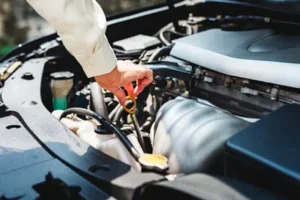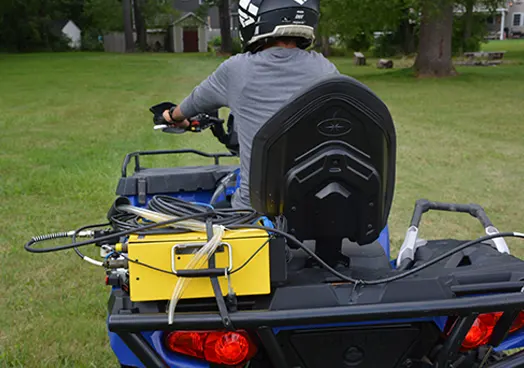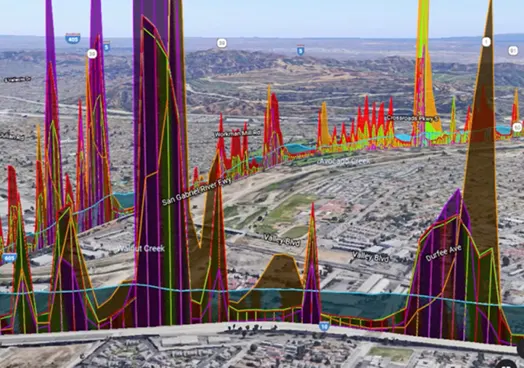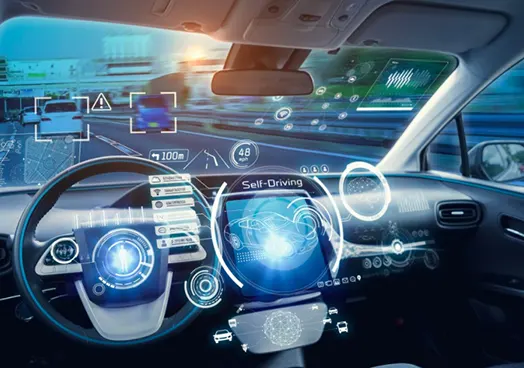
Businesses and original equipment manufacturers (OEMs): in addition to allocating funds for research and development, quality assurance, and other key environmental, social, and governance (ESG) reporting procedures, you’ll need to budget for LDAR.
“L what?” Yup, LDAR: leak detection and repair programs.
LDAR refers to U.S. Environmental Protection Agency (EPA) regulations designed to help decrease the spread of volatile organic compounds (VOC) and volatile hazardous air pollutants (VHAPs) into the air.
While these regulations do a world of good for our environment and the people we love, regulations can be a source of stress and tension if not included in an overall compliance plan.
Plus, the last thing you need on your plate is a call from the EPA inquiring about the status of your emissions reporting and leak detection protocols.
GlobalMRV here: for decades, our team of PhD researchers, managers, analysts, engineers, and technicians have helped businesses and OEMs create more sustainable emissions monitoring programs for all their compliance needs.
If you’re looking to educate yourself — or to refresh your memory — on leak detection and repair (LDAR) programs, you’ve come to the right place.
In this comprehensive review, we’ll discuss:
- What LDAR is
- Why it’s important
- 5 different elements of a successful LDAR program
- 3 key LDAR regulations and standards
- The benefits of implementing and running a successful LDAR program
Join us as we explore all you need to know about leak detection and repair (LDAR).
Why track leaks with a leak detection and repair (LDAR) program

Why track leaks? To decrease and eliminate unintended emissions of liquid and gas-like substances into the air.
Cue leak detection and repair (LDAR) programs.
Since companies are required by law to implement LDAR programs to reduce the spread of volatile organic compounds (VOCs) and volatile hazardous air pollutants (VHAPs), operating without an LDAR program can cost you.
According to the Environmental Protection Agency (EPA), penalties can range from as little as $250 to as much as $37,500 for lapsing on keeping records of leaks. If for no other reason than to keep the environment clean — and to avoid fines and penalties from federal regulators — having a well-thought-out and sustainable LDAR program can save you time, money, and precious resources.
By identifying and repairing leaks, companies can ensure a safer workplace, reduce product losses, decrease the potential for lost revenue, and ensure a cleaner environment with fewer harmful air emissions.
But how does one create an LDAR program that stays in compliance with ever-changing federal regulations? The answer: with the help of knowledgeable sustainability consultants.
Sustainability consultants can help you develop an outstanding LDAR program that meets your company’s compliance-related needs while ensuring your operation stays on the up and up.
5 Elements of a solid LDAR program

Speaking of programs, at this point, you might wonder, “What exactly is included in an LDAR program?”
An effective LDAR program has five main elements:
- Easily identifiable components
- A well-definition of the term “leak”
- Components listed and monitored
- Components that need repairing
- Record keeping of leaking equipment (and more)
We’ll take a look at each in greater detail in the next sections.
1. Identify equipment inventory components
Understanding what makes a solid automotive or real-world driving operation — an operation that’s free from leaks — starts with understanding what makes an efficient manufacturing operation.
To do so, we need to identify which components need repairing. When identifying equipment inventory components, each component under an LDAR program needs an assigned identification number.
Each component’s corresponding physical location is verified as well.
For example, an automotive company that wants to detect the source of leaks in a vehicle would use barcoding and a computerized maintenance management system to help identify and track which equipment components are in disrepair.
Then, specialists and environmental consultants can work together to determine how to fix the equipment and better monitor onboard vehicle emissions output from a manufacturing operation.
2. Define what constitutes a leak
Every company that monitors and reports emissions outputs should have a clear, well-thought-out definition of what’s considered a leak. This definition should include the parameters that constitute a leak.
Furthermore, relevant personnel should be familiar with these definitions, as well as how to document and communicate the leak with all parties involved in monitoring leaks.
3. Monitor the components that could lead to leaks
After leaks have been defined and components have been identified, each identified component should be monitored on regular intervals.
All individuals should familiarize themselves with this monitor interval, so they can monitor and repair leaks with ease.
4. Fix components needing repairs
Now that working definitions, schedules, and components have been identified, it’s time to repair leaking components.
Teams should aim to repair the leaking components within a set amount of time. For example, the first leak should be addressed and repaired within five days after the leak is detected.
Of course, if a delay occurs, and teams can’t service components on schedule, operations teams should leave a well-documented explanation of why the repair work was delayed.
5. Recordkeeping
Speaking of documentation, all tasks and activities performed or scheduled should be documented. To avoid fines with regulatory authorities and minimize unplanned downtime, keeping detailed records of repairs can provide proof of the repairs you’ve conducted to authorities.
Also, records will help your team take the appropriate actions at the right time to keep your operation in tip-top shape.
Whether using a continuous emissions monitoring system or a portable emissions monitoring system (PEMS) to track the emissions output of leaking components, you’ll want to note your findings to maximize the efficiency of your operation and minimize the chance of incurring potential non-compliance penalties.
3 Common regulations and standards to help with LDAR

The three most common regulations and standards that help govern leak detection and repair (LDAR) programs are:
- Method 21
- F40 CFR 60
- Texas Commission on Environmental Quality (TCEQ) permits
By having a working knowledge of each regulation and standard, you’ll be able to increase the efficiency of your operation and meet federal authorities’ emissions requirements.
1. Method 21
Method 21 isn’t necessarily a set of regulations or standards as much as they are guidelines and best practices for determining how to reduce the spread of volatile organic compounds (VOCs) and other harmful leaks.
These guidelines came about in response to the growing need for guidelines for how to detect, repair, and monitor coated components that are subject to staining, discoloration, blistering, or breaches.
2. F40 CFR 60
The Environmental Protection Agency (EPA) created F40 Code of Federal Regulations (CFR) 60, which outlines pollution control standards to help maintain air quality. Also known as New Source Performance Standards (SNPS), F40 CFR 60 discusses ways to reduce and eliminate the release of air pollutants.
What’s more, for new motor vehicles or engines that contribute to air pollution, the Clean Air Act section 202(a)(1) acts as a set of emission standards for monitoring and curbing vehicle-related air pollutants.
3. Texas Commission on Environmental Quality (TCEQ) permits
The Texas Commission on Environmental Quality (TCEQ) identifies the compliance standards needed to obtain permits for companies whose operations could contribute to air pollution.
For example, for gas and oil companies, TCEQ issues permits that help companies prevent pollution and decrease industrial process-related emissions.
Benefits of leak detection and repair (LDAR) programs

When it comes to keeping tabs on leaks, an LDAR program can help improve safety and decrease greenhouse gas (GHG) emissions output.
Leak detection procedures can help with the following:
- Decrease costs associated with unplanned equipment downtime
- Reduce potential fines and penalties levied
- Contribute to worker safety in and around the facility
- Protect our environment from the spread of harmful GHG emissions
Particularly for original equipment manufacturers (OEMs) who operate equipment on gas and oil sites, locating and repairing leaks associated with GHG emissions can be easier with the help of PEMS and HaaS.
Fast facts for you

Co-operative service models have the power to help OEMs detect leaks and monitor vehicle emissions at a fraction of the cost. Co-operative service models are services that are used and shared by multiple companies all in the service of the same goal.
For example, in a Harvard Dataverse study, a reduction of 0.01 – 4.0 t CO₂ occurred when companies opted to share emissions monitoring services using a cooperative service model.
At GlobalMRV, we provide emissions monitoring services to a variety of industries.
Furthermore, whether using LDAR programs or monitoring your vehicle’s emissions, we want to help companies understand how regulations on vehicle performance and emissions can affect their company’s output.
To make more informed decisions about your vehicles for decision-making and more, check out our handy graphic which identifies different vehicle classifications here.
GlobalMRV: The industry’s leading vehicle emissions monitoring team

In summary, a leak detection and repair (LDAR) program helps manufacturers establish a system to find and fix leaks in pumps, compressors, valves, and other equipment components.
A successful LDAR program must have the following:
- A clear definition of what constitutes a leak
- A process to identify, monitor, and repair components needing fixing
- A well-organized system for recordkeeping
With a comprehensive LDAR program in your toolkit, all that’s left to do is ensure your business stays green and EPA-compliant. To do so, surround yourself with reliable partners who will ensure your operation is sustainable for the long haul.
We’d like to be that partner for you.
In the last decade alone, we’ve collected and analyzed over 3,000 hours of reliable data. We’ve also helped save OEMs and companies more than $5,000,000 on emissions testing.
What’s more, our team of Ph.D. researchers, managers, analysts, engineers, and technicians have run more than 60 different types of diagnostic testing regimes for emissions reduction and fuel calibration testing.
Finally, if you’re interested in learning about how GlobalMRV helps companies with emissions monitoring for LDAR, contact us. We look forward to being of service to you.
FAQ about leak detection and repair (LDAR)

What is LDAR?
LDAR stands for leak detection and repair (LDAR). An LDAR program refers to the U.S. Environmental Protection Agency’s (EPA) regulations targeting businesses and companies.
These regulations address reducing the spread of volatile organic compounds (VOCs) and volatile hazardous air pollutants (VHAPs).
Why is LDAR important?
LDAR programs are instrumental in the quest to curb greenhouse gas emissions.
In addition, LDAR programs promote a safer work environment and reduce product losses. These programs also contribute to a company’s overall goal of reducing the release of harmful air pollutants.
How do you implement LDAR?
To implement a successful leak detection and repair program, employees should learn the regulatory requirements and benefits of implementing an LDAR program.
Also, managers should establish written guidelines for LDAR programs. These programs should discuss operational procedures, maintenance requirements, and leak rate goals (among other considerations).